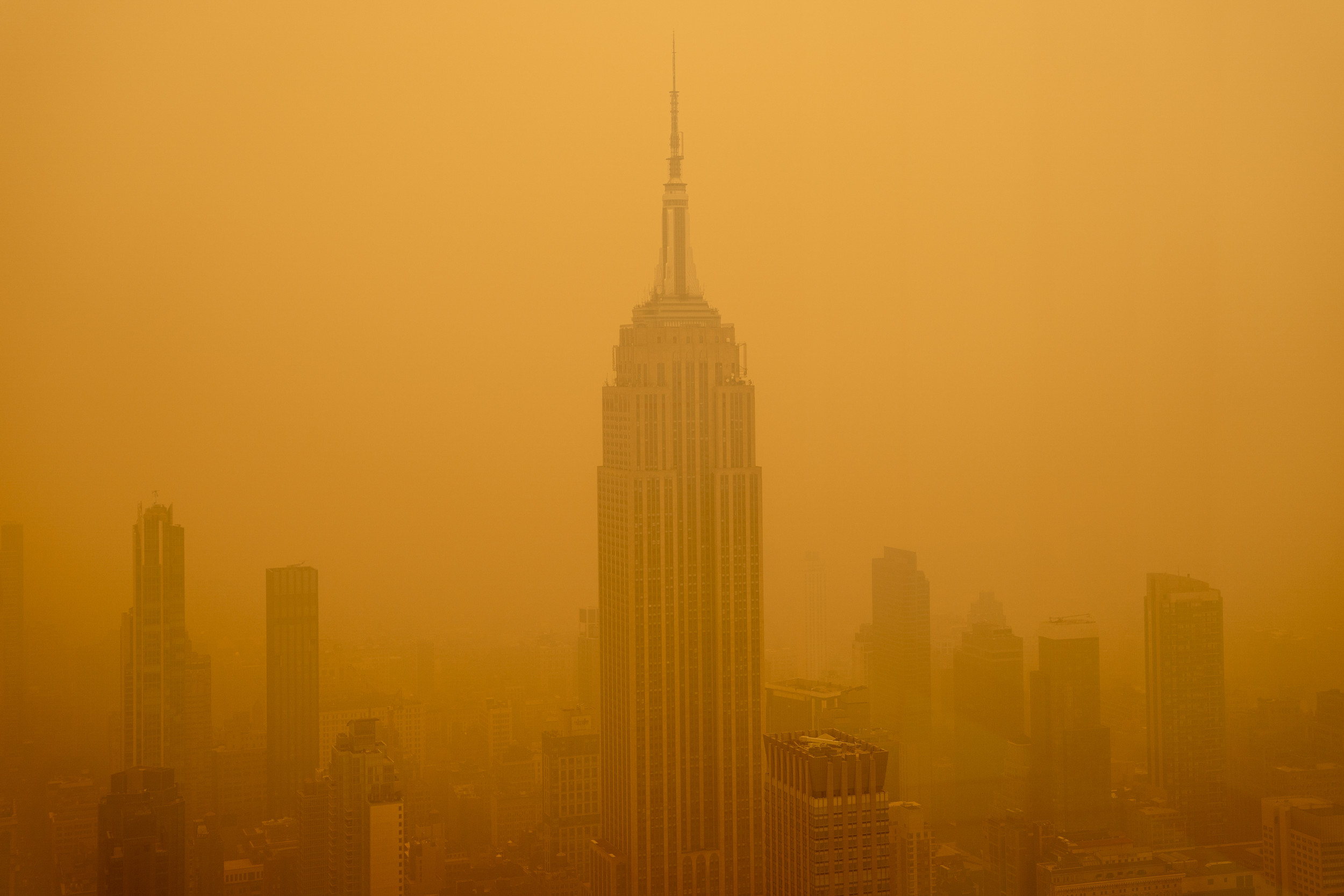LISTEN TO THIS ARTICLE:
Each summer brings waves of smoke and heat to more and more people around the globe. We’ve known for a long time that air pollution causes numerous health issues, including cardiovascular diseases, respiratory diseases, and cancer. However, you might be surprised to learn that bad air quality is harmful to mental health as well. In fact, the presence of fine particulate matter (PM2.5) and other harmful pollutants has been associated with various psychological and psychiatric conditions in a growing body of research.
What types of pollutants are harmful?
When we think of bad air quality, two different sources usually come to mind: human-created pollution and wildfire smoke. Despite their different origins, they often carry similar toxins. Particulate matter is one of the most commonly discussed in media these days, especially those sized under 2.5 microns (PM2.5) and under 10 microns (PM10). For perspective, a human hair is between 50 to 70 microns across. PM2.5 pollutants present the biggest danger to our health and are a major ingredient in wildfire smoke.
Other dangerous airborne chemicals include ozone and toxic gases. Ozone exists naturally at high altitude in the earth’s atmosphere, but at ground level it is pollution from human sources and dangerous to health. Toxic gases include carbon monoxide and carbon dioxide as well as compounds containing sulfur (SOx) and nitrogen (NOx). These mostly come from vehicle and industrial emissions.
Air quality effects on mental health
Anxiety and mood disorders
Studies looking at bad air quality and mental health have discovered impacts relating to not only anxiety and depression but also bipolar disorder, and risk for suicide. Researchers from China managed to link higher levels of anxiety and depression to fine particulate matter. Adolescents exposed to the worst levels of air quality were 29% more likely to develop symptoms of these conditions. A study looking at children in urban areas in southern California specifically linked ozone exposure to increased risk of ED visits for mental health symptoms as well as self-harm, suicide and violent injuries.
A study in Britain that followed almost 400,000 adults for over 10 years found a similarly strong correlation between bad air quality and the increased risk of developing anxiety and depression. American researchers using the Medicare database followed millions of people age 65 or older for several years. They found an increased incidence of depression in older people exposed to high levels of particulate matter, ozone, and nitrogen dioxide.
Behavioral changes
Bad air quality affects how people act and how they view the world around them. Another study from China found that living in polluted air made adolescents withdraw socially, be less optimistic about the future, and make them less motivated in many areas of life.
Some research has even linked bad air quality to higher incidences of unethical behavior, such as law-breaking or going against social norms. How could this possibly happen? It turns out that elevated anxiety levels from air pollution leads people to change their behaviors in ways that benefit them to the detriment of others. When people are anxious, research shows they are more likely to hyper-focus on their own needs even when it means breaking rules. Studies looking at both adults and children show these patterns. Children exposed to bad air quality had more problematic behaviors. These were mainly internalizing behaviors, such as social withdrawal, loneliness, and sadness.
How could this happen?
All of this may sound hard to believe for some. Surely, living in areas with bad air quality may affect how we feel a little, but it must be purely psychological, right? Actually, there are several biological processes that may be contributing to these changes.
Access to the brain
These toxic chemicals enter your blood stream either through the lungs or via the blood vessels in your nose. Once in the blood, they are small enough to penetrate the blood-brain barrier (BBB). This is a highly specialized safeguard that separates the circulating blood from the brain and spinal cord tissues. It is composed of a layer of tightly packed cells that line the blood vessels in the brain and is meant to protect the brain from potentially harmful substances while allowing essential nutrients and oxygen to pass through. Unfortunately, the BBB just doesn’t stand up well to modern air pollution.
Chemical damage
Many of the studies we’ve discussed theorized that these symptoms could be related to inflammation and oxidative stress from pollutants. Inflammation is most closely linked to fine particulate matter. When these tiny particles get into the blood and spread throughout the body, they can cause inflammation anywhere and everywhere. In the brain, they can over-activate microglia, part of the immune system in the brain, leading them to cause damage when they normally wouldn’t.
Oxidative stress is an imbalance between the level of reactive oxygen species (ROS) and the ability of the body’s antioxidant defenses to neutralize them. ROS include chemicals like ozone, which is dangerous because it can cause damage to important parts of the body’s cells, including cell membranes, proteins, and DNA. This puts people at higher risk of numerous issues, including the mental health problems we’ve discussed here.
Stress response
Pollutants in bad quality air can even affect how the brain and body manage stress. Research looking at gene expression found that toxins in bad quality air changed how the body activated different genes. When the body “expresses” a gene, that means it uses that gene to make a protein, which then goes on to perform a function in the body. In this case, pollutants are pushing the body to express stress-related genes. This leads to higher concentrations of stress hormones in the body and over-activation of the stress systems.
Protect your mental health from bad air quality
As dangerous air quality becomes more and more commonplace, we need to take steps to protect the mental health of ourselves and those we care for. Weather services have already become adept at predicting bad air days. The AQI (Air Quality Index) is a standardized rating system that provides information about air quality and associated health risks. The AQI takes into account the pollutants we have talked about, including ozone, particulate matter, carbon monoxide, sulfur dioxide, and nitrogen dioxide.
The best and most effective step to take is to use these AQI predictions to determine your behavior. When you have the choice, stay inside with windows closed on bad air days. Invest in a HEPA filter for your home. If you normally exercise outside, hit the gym instead. You can also fight negative thoughts related to the bad air quality with relaxation techniques. When you have to go outside during bad air quality days, an N95 mask is your best friend. These masks, now more widely available than ever since the pandemic, block out a lot of harmful particulate matter. Unfortunately, there is no easily accessible mask that blocks out other harmful chemicals like ozone and carbon monoxide. Most often, the safest place is inside, away from the bad air.

 Learn
Learn Read Stories
Read Stories Get News
Get News Find Help
Find Help

 Share
Share
 Share
Share
 Share
Share
 Share
Share



